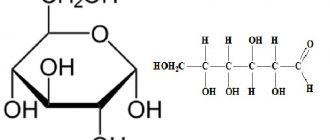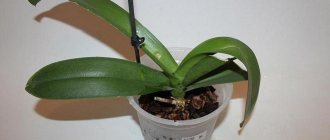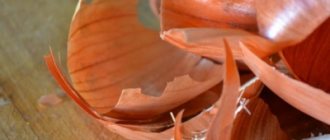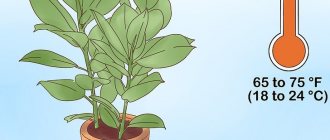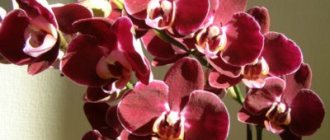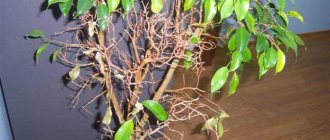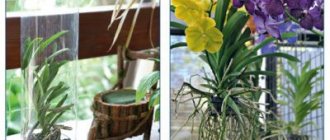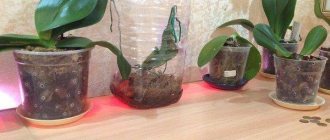- Growth period
Beautiful orchids, mainly various varieties of the Phalaenopsis genus, have long taken pride of place on the windowsills of apartments and private houses. These representatives of tropical flora captivated Russians with the shape of the flower, reminiscent of a butterfly, the variety of colors, the long flowering period, and the availability of purchase. Experienced flower growers know that to maintain a flowering appearance, a plant needs to be provided with a constant temperature, a certain regime of lighting, humidity, and fertilizing. We will tell you in the article what and how to feed an orchid.
Phalaenopsis (pictured) is one of the species most common in home floriculture
Nutrient requirements
The need for nutrients directly depends on the time of year.
In spring and summer , thanks to long daylight hours and elevated temperatures, orchids can process more nutrients faster than in winter and autumn , when the temperature drops and daylight hours are shortened.
Each nutrient and the product of its transformation has its own purpose for the development and well-being of plants.
Depending on their role in metabolism, all nutrients can be divided into two groups:
- BUILDING ELEMENTS are substances necessary for a plant to form its organs (leaves, root system, etc.).
This group includes: proteins, fats, carbohydrates, organic acids, carbon, hydrogen, oxygen, nitrogen, phosphorus, sulfur, etc.
- FUNCTIONAL ELEMENTS are substances that influence certain processes occurring inside plants.
This group includes: potassium, calcium, magnesium, zinc, iron, boron, manganese, copper, molybdenum, chlorine and others.
Types and composition of fertilizers
There are 3 main groups of fertilizers:
- Organic;
- Inorganic;
- Chelates.
Organic fertilizers
They are of natural origin.
As a rule, these are waste products or decomposition products of animals and plants (bone meal, manure, humus, bird droppings, compost, etc.).
For the most part, such fertilizers contain nitrogen , which in its pure form is not available to plants.
In order for the orchid roots to begin to absorb such fertilizer, it must be processed by microorganisms.
This process directly depends on:
- composition and degree of substrate moisture;
- general temperature of the plants;
- total number of microorganisms.
The process of processing substances occurs uncontrollably.
Nitrogen may be produced either too little or too much.
In organic fertilizers, the remaining microelements necessary for orchids are either not contained at all or in a very low proportion.
Inorganic fertilizers
It is obtained synthetically by mixing macro- and microelements in certain doses.
Inorganic fertilizers are quickly absorbed by orchids, but they strongly salt the substrate and are difficult to wash out of the pot.
Most mineral complexes contain 3 main elements :
- Nitrogen (N);
- Phosphorus (P);
- Potassium (K).
The following can be added to the main elements in small quantities:
- Iron;
- Calcium;
- Manganese;
- Zinc;
- Molybdenum;
- Magnesium;
- Boron;
- Seru.
Fertilizer packages always contain the exact ratio of all three elements. For example, N:P:K = 10:4:7, which in turn means that nitrogen, phosphorus and potassium have a ratio of 10:4:7.
Sometimes the fertilizer packaging indicates the ratio of four numbers, the fourth being magnesium.
Modern complex fertilizers for orchids contain these microelements in different proportions.
Depending on the ratio of fertilizer elements, there are:
- Balanced;
- Nitrogen;
- Phosphorus.
A fertilizer with an NPK formula of 20-20-20, 12-12-12 or 6-6-6 is called balanced . There are equal amounts of all elements in such a fertilizer, but in absolute numbers there are most of them in the first formula.
The formula of nitrogen fertilizer is most often NPK 30:10:10. There is more nitrogen in this fertilizer than phosphorus and potassium.
Nitrogen fertilizer is used limitedly - at the beginning of the growing season for orchids planted in organic substrates (untreated bark, peat).
Organic substrates, immediately after the start of use, begin to decompose little by little and are colonized by bacteria, which absorb most of the available nitrogen. Therefore, the risk of overfeeding the orchid with nitrogen is minimal.
Phosphorus fertilizers, for example, NPK 10:30:20, are used to stimulate abundant flowering. The best time to apply phosphorus fertilizer is 1-2 months immediately before the expected flowering period.
More details about the signs of deficiency or excess in the next article.
Chelates
Unlike the first two varieties, they are absorbed by the root system (and leaves) almost instantly.
Chelate (from the Greek chele, “claw”) is a complex organic complex, a chemical combination of a trace element with a chelating (capturing) agent.
Such an agent firmly holds microelement ions in a soluble state until they enter the plant.
Then it releases it, converting it into a biologically accessible form, and itself breaks down into chemical compounds that are easily absorbed by plants.
Chelated fertilizers can be “ single ”, including only one microelement (for example, Fe-EDTA or Fe-DTPA), or they can be complex (for example, an aqueous solution of chelates of microelements Mn, Zn, Cu, Mo based on HEDP).
They have a positive effect not due to the substances they contain. Beneficial microorganisms simply facilitate the absorption of nutrients that are already present in the substrate.
With the correct dosage, in addition to the positive effect, they do not cause any obvious or hidden damage to the plant.
Release form
Flowering sticks
The sticks are suitable for all types of orchids, have a balanced composition, and gradually dissolve in the pot under the influence of moisture and heat. A healthy plant is formed that blooms profusely.
Liquid substances
Liquid complex fertilizers have a balanced composition, their use promotes good development of the root system, increases the duration of flowering and, in general, increases the plant’s resistance to pests and diseases. Sold in the form of ready-to-use sprays and concentrates for the preparation of aqueous solutions.
Pills
Tablets are an excellent tool for activating the growth of leaves, roots, and also for increasing bud formation. The use of drugs in the form of tablets increases the intensity and duration of flowering and improves immunity.
Fertilizers are also sold in the form of water-soluble powder, granules and paste.
Fertilizing orchids at different periods of development
At different periods of orchid development, fertilizer compositions with different ratios of components are used.
The content of nitrogen, phosphorus and potassium in them depends on what phase the orchid is in:
- During the period of active growth, a fertilizer with a high nitrogen content is necessary, since nitrogen is responsible for the growth of vegetative mass.
- During planting and budding, fertilizer with a high content of phosphorus and potassium is necessary.
Isn't it time to feed?
If there is a nutritional deficiency, the orchid itself will attract attention. The need to apply fertilizers is indicated by:
- long absence of flowering;
- the plant blooms, but the flowers are small and fall off;
- cessation of growth of new leaves or their shrinkage;
- change in leaf blade color (lightening);
- the lower leaves turn yellow, dry out, and die.
It’s easy to guess that it’s time to feed your orchid at home by the appearance of the plant.
How to feed an orchid?
When deciding how to feed an orchid, it is worth taking into account the species characteristics and place of their growth in nature.
Feeding for epiphytes
Epiphytes include such representatives as phalaenopsis, vanda, cambria, dendrobium, etc.
Their nutrient requirements are low. In nature, these plants are content with the grains that rain washes off the trees.
IMPORTANT! For epiphytes, it is recommended to use only mineral fertilizers.
Feeding requirements for terrestrial species
Terrestrial orchids include some types of paphiopedilum, growing in rock crevices where various organic remains, cymbidium, ludisia, etc. accumulate.
Their need for nutrients is higher, because decomposing organic remains are always present on the ground (rotted leaves, grass, branches, animal waste products).
They respond well to the addition of organic matter, in addition to mineral complexes. For example, cymbidiums often refuse to bloom unless organic matter with a sufficiently high nitrogen content is added.
IMPORTANT! Before using the fertilizer, be sure to read the instructions for its use. Strictly observe the dosage.
Common mistakes
- High concentration of active ingredient in universal fertilizer.
- Too frequent use of fertilizers. You should follow the watering schedule so as not to “overfeed” the plant.
- Storing the diluted working solution. The orchid should be watered with the prepared mixture immediately, since the composition loses its effectiveness during storage.
- Feeding a flower that has not been watered for a long time. The roots have dried out, and fertilizing can burn them.
- An orchid that was already blooming when it was purchased at the store is fed.
Fertilizer application methods
There are two ways to deposit:
- Root feeding.
Using this method, the roots are soaked or spilled with a solution containing fertilizer.
- Foliar (foliar) feeding.
Fertilizers are applied to the leaves, most often using a spray bottle. Since most of the stomata on leaves are located on the lower part of the leaf, this is where fertilizer should be sprayed.
Foliar feeding can be used in parallel with root feeding, or can be used independently when the orchid does not have roots or it is necessary to deliver microelements directly to the leaves (for example, during chlorosis).
IMPORTANT! The use of fertilizers in the form of sticks or tablets is not recommended, since in conditions of breathable substrates based on the bark of coniferous trees, they have a very small positive effect on orchids.
Reviews
Irina, Moscow (Pokon). “I only have four orchids, but I try to give them the best care. Fertilizers from Pocon help me with this. I have been using this brand for quite some time. Economical, convenient and effective. I am always confident in the quality, the result consistently meets expectations.”
Evgeniy, St. Petersburg (Mr. Color). “Once I decided to try this fertilizer for my palm trees - I liked it, and I bought it for orchids. Since then I forgot about the agony of choosing fertilizers. A good drug, no questions asked. I use it according to the instructions, but I try to add a little less than necessary. All orchids bloom consistently every season.”
Anastasia, Yaroslavl (Agricola). “It is well suited for flowering, as it contains a lot of phosphorus. I fertilize in the “summer” period twice a month, by immersion for 20 minutes. Orchids grow and bloom well. When they grow buds, I reduce the concentration. Gives good results, can be stored in the cold, and is also suitable for other beautiful flowering plants. No better and no worse than others. Convenient glass included.”
Lydia, Ryazan (Bona Forte). “I use it to stimulate growth. I feed in spring and until mid-summer. Then I switch to fertilizers with a focus on phosphorus. I alternate root feeding with leaf feeding, and use sprays from third-party manufacturers. If you use your head a little, this combination of different fertilizers at the right time gives better and more controlled results.”
Rules for feeding orchids
It is best to use a specialized fertilizer, marked on the package “For orchids,” since they are specially balanced in relation to the needs of the orchid and cause the least harm to their root system.
The substrate is a special microclimate where various bacteria, fungi and other microorganisms live.
When fertilizing, you fertilize not only the orchid itself, but this entire friendly family taken together.
Each component of which, to one degree or another, is involved in the processing of fertilizer in order to extract useful elements from it and present them to the orchid roots in a form accessible for absorption.
The processing of many useful substances takes a fairly long period - first they accumulate in the substrate, are gradually processed by microorganisms, and then end up inside the orchid.
The older the substrate , the greater the number of such elements it contains , and the higher the likelihood that too many substances will accumulate and they will become toxic to nearby roots.
Salinization of the substrate will occur , followed by massive death of roots.
In order to avoid this, orchids growing for a long time in old substrates need to be fertilized an order of magnitude less often than in new ones.
The opposite situation occurs inside pots of recently transplanted orchids .
At first, the microflora necessary for the further promotion of beneficial substances is practically completely absent.
To build it, you will need not only a certain period of time, but also a large amount of nitrogen (especially in clean bark).
It is not uncommon during this period when orchids begin to suffer from a lack of it, turning yellow and dropping leaves, because all the nitrogen available for nutrition is spent on building new microflora.
Folk remedies
Folk remedies are an excellent alternative to store-bought ones. Their main advantage is the ability to make them yourself at home. Experienced flower growers recommend paying attention to the following products:
- Yeast and sugar (can be replaced with glucose). Solutions based on these products help accelerate plant growth, replenish vital energy reserves and increase resistance to diseases. One gram of dry yeast and one teaspoon of sugar per liter of water is enough. The solution is infused for one day, and then it can be used to water and spray the plant.
- Garlic. Garlic water or infusion is made from it. You will need two or three cloves of garlic, which should be crushed with a knife and poured with a glass of water. You need to insist for at least two hours. The product perfectly helps cope with harmful insects and pathogenic microorganisms.
- Hydrogen peroxide. It is distinguished by its disinfecting properties, so solutions based on the product are useful. They water plants to disinfect damage. You will need a 3% solution of the product, which is diluted on the basis that 30 milliliters of peroxide is enough for one liter of water.
- Sugar. Sweet water is made from it. It is known that glucose is necessary for plant growth. When diluted, one tablespoon of sugar per 500 milliliters of warm water is enough.
- Honey. It is used to make honey water, which is rich in vitamins and microelements necessary for plant growth. The product is diluted in the proportion of one third of a teaspoon per glass of water.
- Banana peel. This product is rich in phosphorus, potassium and nitrogen. First, the peel of one banana needs to be infused in one liter of warm water. Then the plant is treated with this infusion.
- Wood ash. This is a mineral fertilizer used to regulate water balance and accelerate the appearance of flower stalks. Can be used dry, sprinkled on soil, and also as a solution with low concentration. It is enough to dilute 200 grams of ash in one liter of water.
- Tea and coffee. These are homemade organic fertilizers, the composition of which contains fewer useful elements and minerals compared to other products. Tea or coffee is brewed so that a slightly colored solution is obtained (its color should be light brown and almost transparent) and used for watering. You can also feed your plants with coffee grounds.
- Water from boiled potatoes. Its composition is rich in potassium. Before use, the liquid must be cooled to room temperature.
- Decoction of onion peels (weak). It contains potassium. In addition, the product helps protect the plant from disease and decay. One glass of husk is enough for a three-liter container of boiling water. You need to infuse the decoction for at least eight hours, and then dilute a glass of liquid with three glasses of chilled, settled water - and you can water the orchid.
- Castor oil. It promotes abundant flowering of the plant. You will need one liter of water in which one teaspoon of the product is diluted. Before use, shake the solution thoroughly so that the oil breaks into small fractions and does not burn the plant.
Note! These types of homemade fertilizers can be used to feed orchids of any type (phalaenopsis, cattleya, vanda and others), as well as their children. The most important condition is the correct ratio of available products to create a balanced composition so as not to harm the plant.
By the way, there are some products that should be in the “first aid kit” for an orchid. These include:
- Charcoal. It is capable of killing pathogens of fungal diseases. The product is used to treat cut areas to dry and disinfect them. For lubrication, mix one teaspoon of powder with a teaspoon of water. To spray, you need to dilute one teaspoon of the product in one liter of water.
- Urea. This is a nitrogen-type fertilizer, which is very useful for weakened plants. In addition, the product is used to bring the plant out of winter dormancy. One teaspoon of the product is enough, which is diluted in one liter of warm water. Can be used after cooling to room temperature.
- Succinic acid. This is a strong product that should be used when needed and not as a regular feeding product. The acid heals the plant, accelerates the growth of the vegetative mass, and stimulates the release of buds. 1 g of product per 500 ml of liquid is enough.
- Ammonium (calcium) nitrate. This is a strong nitrogen fertilizer used in cases of poor growth, lack of appearance of new leaves, prolonged stay of the plant in the dormant phase, loss of color. For root feeding you will need 2 g of ammonium nitrate per 1 liter of water, and for foliar feeding you need to take a solution twice as weak.
Nutrient deficiencies
You can regularly fertilize an orchid , but it will still suffer from a lack of one or another substance.
Why is this happening? The main reason lies in the suboptimal acidity of the substrate, determined by pH.
The optimal value for most types of orchids is between 5.5 and 6.5 pH . When the pH is below 5 or above 6.8 pH, an unfavorable environment is formed inside the substrate and the orchid root system stops consuming many nutrients.
In acidic soils (pH 4.0-5.5), iron, aluminum and manganese are in forms available to plants, and their concentrations reach toxic levels. At the same time, the supply of phosphorus, potassium, sulfur, calcium, magnesium, and molybdenum to plants is difficult.
In alkaline conditions (pH 7.5-8.5), iron, manganese, phosphorus, copper, zinc, boron and most trace elements become less available to plants.
What affects the decrease or increase in pH of the substrate?
From frequent watering, many organic components of the substrate begin to decompose, and its pH decreases. This indicator increases due to frequent fertilizers or watering with (hard) tap water.
The roots of many epiphytic orchids are very sensitive to various types of potassium, phosphorus, etc. salts contained in fertilizers and exposure to highly concentrated fertilizer can cause burns.
REMEMBER that ordinary fertilizers for indoor plants are oriented towards action in ordinary soil and for absorption by ordinary, NOT EPIPHYTIC roots, so their main drawback is the rapid salinization of the substrate, which creates an unfavorable environment for the root system of orchids inside the pots, in especially sad cases leading to their mass die-off.
